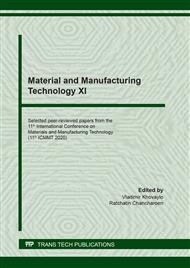p.96
p.102
p.108
p.114
p.123
p.131
p.141
p.147
p.153
Enhancement Bending Strength of Non Fired Wall Tiles by Recovering Sand-Wastes By-Products from Kaolin Beneficiation Process
Abstract:
Kaolin beneficiation mining is one of the sectors in a supply chain of ceramic industries, supplying qualified raw materials for manufacturing high-quality ceramic products. However, substantially by-products are generated from the mining process. The abundance fraction of sand-wastes is generated by approximately 40% of kaolin material input, amounting to 172,200 tons/ year. The burden of the manufacturer is attempting to find out the way to solve this problem. The effort of this research is to utilize waste by-products (sand-wastes) from kaolin mining. The eco-friendly Non fired wall tiles are developed with the combination of sand-wastes, laterite soil, river sand, and Portland cement Type I. They have been compared with the Thai Industrial Standard (TIS 2508-2555). Results of the experiment show that the proposed wall tile can achieve the physical properties of TIS 2508-2555. Scanning Electron Microscope (SEM) has been studied to analyze the surface morphology of specimens. This can be summarized that 25% of sand-wastes can be utilized in wall tiles. In addition, energy-saving for non-firing products is achieved. Furthermore, energy-saving is also calculated and compared with fired wall tile which has similar properties.
Info:
Periodical:
Pages:
123-130
Citation:
Online since:
February 2021
Price:
Сopyright:
© 2021 Trans Tech Publications Ltd. All Rights Reserved
Share:
Citation:


